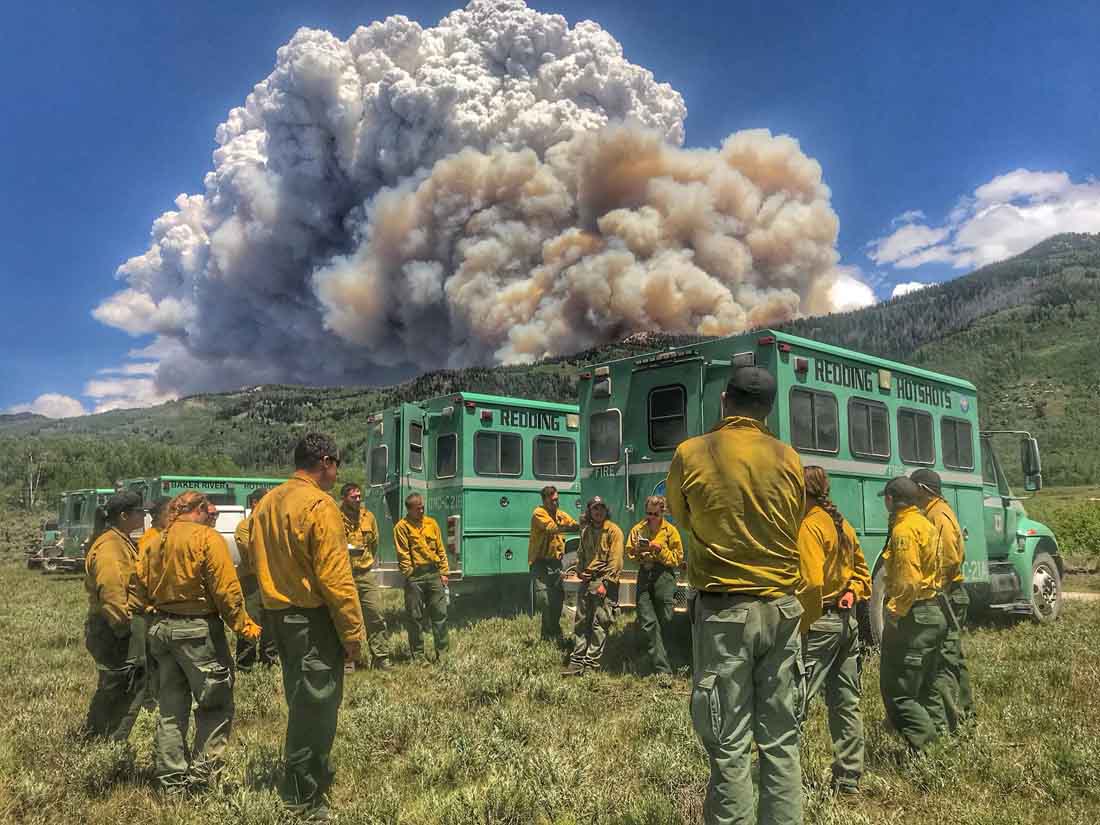
The National Incident Management Organization (NIMO) teams are working on procedures for managing wildland fire organizations and suppressing wildfires during the COVID-19 pandemic. Here is an update from NIMO.
Friday May 1, 2020
NIMO has been involved for some weeks now, with the development of a fire/COVID-19 simulation to help IMT’s and Agency Administrators prepare for fire in the new COVID environment this coming summer. If you wish to take part in one of the regional simulations, please contact your GATR..
COVID-19 Wildland Fire Simulation Development and Delivery
Date: April 27, 2020
Summary: Fire and Aviation Management (FAM), Workforce Development, Risk Management, Human Dimensions-Rocky Mountain Research Station, and National Incident Management Organization are collaborating to develop and deliver a late spring 2020 COVID-19 Wildland Fire Response Simulation.
The intended audience is Line Officers, Type 3 and higher complex Incident Management Teams (IMTs), and community partners. The intent of this virtual simulation is to facilitate dialog with Line Officers and IMTs on the use of Best Management Practices to make informed decisions, while providing an opportunity to evaluate and learn from those decisions. The exercise will highlight leadership principles and concepts, risk assessment processes, Gifford Pinchot’s Maxims, agency policy and direction; all within a complex fire situation under the constraints of a Coronavirus Disease 2019 (COVID-19) environment where participants will perform functional and team responsibilities.
The simulation will provide for both Operational Risk assessment and Quantitative Risk evaluation using the Risk Assessment Worksheet (RAW, and tools such as the atlas of Potential Control Locations (PCL), Suppression Difficulty Index (SDI), and asset layers.
This simulation will also prepare Line Officers and IMTs to use a whole host of decision tools including the 2020 Chief’s letter, Leadership Stance and Habits, and Center for Disease Control guidance, while evaluating decisions based on Social, Political, Health, and Safety considerations. Each simulation will be broken into two parts:
1) Morning session consisting of education, policy, guidance, and information
2) Afternoon session is the simulation with practical exercises
The Simulation will break participants into four teams to include representation of Line Officer(s), IMT Command and General Staff section chiefs, and partners, totaling no more than10 people per team. Delivery will be through Adobe Connect and will begin with Alpha and Beta test deliveries. Each delivery will be followed by an After Action Review (AAR). Closed captioning capabilities are available with at least a 48-hour notice prior to delivery. Below is the tentative schedule.
1. May 6 – Alpha delivery to Field Command School and NATP students
2. Week of May 11 Beta delivery to Regions 8 and 9
3. Week of May 18 Delivery to Regions 3 and 10
4. Week of May 25 Delivery to Regions 2 and 5
5. Week of June 1 Delivery to Regions 4 and 6
6. Week of June 8 Delivery to Region 1
Regional Training Officers will be advertising for, and prioritizing, participants for each simulation.
Please contact Jay Winfield at jay.winfield@usda.gov or 208-993-0768 for additional information.

The whole having a plan, punched in the face thing…..
I’ve been wondering what they’ll do with all the 20-59 plus year old FFs
Demographics of positive cases statewide
0.8%. Under 10
4%: Age 10-19
12%: Age 20-29
15%: Age 30-39
14%: Age 40-49
17%: Age 50-59
13%: Age 60-69
14%: Age 70+
10%: Unknown
The only thing that makes your question appear insensitive, is, the fact that it is insensitive.
Older people have a higher mortality rate, due to underlying health conditions. However, by your statement, it’s alleges that only those 65 and older are at risk, while nothing could be further from the truth. We are all at risk, we all could be affected by this virus. How many of us know if we have “underlying” health issues? Do we all perceive ourselves to be out of the reach of this virus? How many years have we all inhaled smoke out on the fire line? Do the research, or I guess read the research papers that are out there about how wildfire smoke effects the lungs. This virus attacks the lungs…..putting two and two together makes me realize that we are all at a higher risk.
Stay well and look after each other, even those over 65 out helping with fires this season
***statistics are from the state of NV and don’t reflect what might be happening in your state/area***
I’ve been wondering what they’ll do with all the 65 plus year old ADs